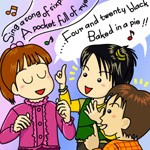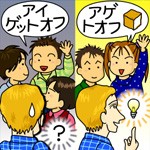Mr Yamazaki:
若葉台小学校は平成14年度から英語活動を導入しています。3年生以上は年35時間(総合)、1・2年生は年10時間(ゆとりの時間)を英語活動に当てています。
(In Wakabadai Elementary School, where I work, we have been teaching English since 2002: 35 hours in Grade 3, 10 hours in Grade 2 and 10 hours in Grade 1.)
QUESTION :
小学校の英語活動において、大切なことは何でしょうか?
(What is the most important aspect of teaching English at elementary school?)
Mr Yamazaki:
日本人は一般的に英語下手の民族といわれていますが、なぜ日本人は英語が苦手かを考えると、小学校英語でやるべき姿が見えてくるように思えます。
(It's said that the Japanese are weak in English. Why is that? I think it's because we haven't been doing what we need to do at the elementary school level.)
<山崎先生が考える、小学校英語のあり方>
(How to approach English at elementary schools)
1.英語を言葉と考えるより音楽と考える --Teach it as music, rather than as language
日本人の多くが「ジャングリッシュ」とやゆされる、母音が強く平板な英語を話します。
これは、日本語が基本的に「子音+母音」で成り立っており、強弱のアクセントが少ないことに由来します。したがって、どの単語にも母音を付けたがり、どの語も同じ強さで読んでしまいます。
(Most Japanese speak English with a strong accent. It's known as "Janglish". This is because the Japanese sounds consist of a consonant plus a vowel, and there is neither a strong nor a weak accent. Hence, Japanese place emphasis on vowel sounds even when speaking English.)

|
|
言葉というより音楽なんだね
|
それを克服するには、英語の持つプロソディー(アクセントやイントネーション)に着目して、英語を音楽ととらえた方が、日本人には発音しやすくなります。音楽にはリズムや強弱が伴います。ジャングリッシュでは、リズムよく読むことができません。
(To over come this, we should focus on accent, and to do that, it's better to teach English as music, I think. It will help the Japanese when they speak English. They will have better pronunciation. Music has rhythm, it has strong and weak emphases. Janglish doesn't.)
また音楽としてとらえると、英語が目からではなく耳から入ることにもなります。つまり、聞いた通り発音するから、余計な音が入らないナチュラルな発音となるのです。
私は、「空耳日本語」という冗談をよく言います。例えば"I get off."という英文をカタカナ英語で読むと「アイ ゲット オフ」とジャングリッシュになりますが、「揚げ豆腐」と発音すると、とてもナチュラルな英語になります。これは、目からではなく、耳で聞いた通りを言ったため、発音しなくてもいい母音や語が落ちたからです。
(If you teach it like music, you can learn it by ear. You don't have to use your eyes. I mean, you pronounce it as you hear it. That way, it won't sound like "Janglish". Here's an example. Say, for example, "I get off.". If you read it in katakana, it sounds like "ai getto offu." But then if you say, "age-dofu," which means fried tofu, it's much closer to the way "I get off" is pronounced in English. This shows that if you pronounce something as you hear it, you won't put in extra unnecessary sounds.)
これらを具現化するために、若葉台小学校では英語の歌を歌ったり、96の構文を歌とダンスで覚える「英会話たいそう」を指導したりしています。また、絵本のリズム読みなども行なっています。
(In my school, we sing in English, and do physical exercises in English. There are 96 basic sentences and kids can learn them through song and dance. We also read picture books using rhythms.)

|
|
大げさにやってみよう |
2.ジェスチャーをつけて話す — Using gestures
日本語は民族や文化的な同一性から、あうんの呼吸で会話を行ない、場の雰囲気をうまく読み取って意味を理解します。したがって、派手なジェスチャーは敬遠される傾向にあります。ですが、英語は民族的な多様性から、できるだけ派手なジェスチャーを付けることでスムーズな意思疎通をはかってきた背景があります。英語の持つリズムも、ジェスチャーを付けることで容易になります。
(The Japanese don't make much use of non-verbal communication. They haven't had much need to. There are other ways of reading situations. So gestures aren't considered that important. However, because English communication is very different, involving a wide range of elements from many different cultures, gestures are very helpful for communicating smoothly. It can also help you get used to the rhythms of English.)
若葉台小学校では、ジェスチャーが付けられるよう、「英会話たいそう」で構文と共にジェスチャーを覚えたり、歌やチャンツにジェスチャーを付けたりして覚えるようにしています。
(In my school, we learn how to use gestures to communicate basic sentences through physical exercises. We also use songs and chants.)
3. チャンク(かたまり)で覚える — Memorize English with "chank"

|
|
山崎先生の授業風景
|
外国人に道で話しかけられて、なかなか英語が出てこないという経験をした人は多いのではないでしょうか?これは単語を頭に思い浮かべて、文法で無理やり英文を作っているからだと思います。しかし、これではスムーズな会話はできないし、結果としてネイティブが話さない、おかしな英語になってしまいます。これを克服するには、構文をチャンク(かたまり)で丸暗記して、シチュエーションに応じたセンテンスを丸ごと会話に用いるしかありません。
(I guess many Japanese people are familiar with the frustration of not being able to express themselves when asked for directions by a foreigner in the street. I think this frustration comes from forcing words one by one into making a sentence. It doesn't make for smooth communication, because most English-speakers won't understand this kind of broken English. To overcome these hurdles, you should memorize basic sentences in chunks, and use those phrases (not individual words) when communication with people.)
「英会話たいそう」はチャンクの宝庫です。子供たちはセンテンスを丸ごと一つの単語のように覚えています。ですから、"This is for you. Really? Thank you. You're welcome." のような一連のフレーズが、スラスラと話せるようになります。また、絵本をリズムで丸ごと覚え、そのフレーズを覚えたり、歌やチャンツから英語の定型表現を覚えたりして、スムーズな会話ができるようにしています。
(This learning of chunks of English, we do through physical exercises. The kids are learning each sentence as if it were one word. So it becomes easier for them to use these sentences, like "This is for you,". "Really? Thank you," and "You're welcome." They also memorize picture books and basic expressions through rhythm and songs and chants. It helps them to converse in English more smoothly.)
4. 度胸を付ける — Don't be timid

|
|
恐れないで
|
落ち着いて冷静に考えれば、何とか話すことはできるのに、外国人に道で話しかけられて、どぎまぎした経験も多くの日本人が持っているのではないでしょうか。これを防ぐには、外国人と1対1で話すことに慣れるしかありません。
(When a foreigner speak to you, if you stay calm, you'll be fine. It's when you start panicking that problems arise. What is the best way to stop panicking? There is only one way, I think. You need to get used to talking with foreigners face to face.)
若葉台小学校では、Question timeという、子どもがALTを独り占めにして一対一で会話をできる場を作っています。ここでは、お別れの握手と共に今までに習った構文を使った質問をします。中の単語を入れ変えて、自分が作った文章を話すこともできます。これによって構文を自分のものにして、相手の目を見ながら話をすることで、会話の基本も身に付きます。そして何よりも、子どもたちはネイティブの先生と英語で会話ができた喜びを感じ、英語をまた話してみたいという意欲をもつことにもなります。
(In Wakabadai elementary School, We have Question Time in English class. In Question Time, The kids converse with the Assistant Learning Teacher (ALT), using sentences that they have learned so far. They are also encouraged to change words and make their own sentence.This helps them communicate with the ALT and learn basic conversation techniques. Moreover, they feel happy talking with the ALTs in English and it also motivates them.)
☆★編集後記☆★
 |
|
空耳英語って・・・
|
「空耳英語」「揚げ豆腐」…なんとも面白いお話ですね。そういえば、昔「空耳英語の歌特集」(外国人が英語で歌っているのに、ある部分が日本語に聞こえてしまう歌)を紹介するラジオ番組がありました。当時爆笑しながら英語を覚えたものです。(そしてなぜかそんな英語はいまだに覚えています!)一般的に、日本人は「目で見ること」や「活字」を気にしすぎて、耳を使ってコミュニケーションすることは慣れていないのかもしれませんね。皆さんはどう思われますか?山崎先生のお話は次回に続きます。お楽しみに!!
(Fried tofu? Who would have thought of that? It reminds me of a radio program I used to listen to as a kid called "Soramimi nihongo no uta tokusyu" which means "English songs that sound like Japanese." It made me laugh so much, and because of that program, I learned English quickly. (Even now, I remember some of it.) In general, when it comes to studying languages, Japanese tend to use their eyes and neglect their ears. What's your opinion?
The interview with Mr.Yamazaki will continues next time. See you then!)
「日本の小学校英語活動・番外編(その1)〜オーストラリア人教師からみた日本の英語教育〜」はこちら
(Click here!)
「日本の小学校英語活動・番外編(その2)〜玉川大学文学部・佐藤久美子先生へのインタビュー」はこちら
(Click here!)








